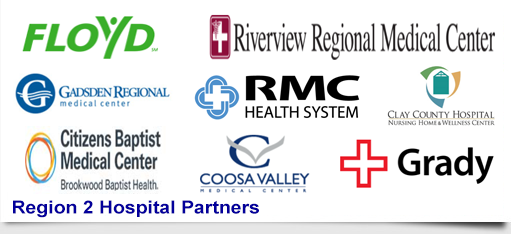East Alabama Trauma System Acitvation
The East Alabama region joined the statewide trauma system on Oct. 6. Under this advanced system, injured patients will now be identified by emergency medical technicians at the scene who will route the patient to the closest hospital which has the resources to care for the patient. The EMT will contact the trauma communications center, which knows the current status of all hospitals in the area, so that the patient is routed only to the hospital best able to care for the patient.
“This system helps save lives of trauma patients by assuring that the patient is always transported or transferred to the best hospital with the available resources for treatment of their medical condition,” said Dr. John Campbell, Medical Director of the Office of EMS and Trauma of the Alabama Department of Public Health.
The Alabama Legislature approved an expansion of the statewide trauma system, which is under the leadership of the Department of Public Health. Alabama will have the first statewide system of this type in the United States. The system will serve as a model for the nation.”
Because trauma patients’ survival rates improve dramatically when they are evaluated, treated and transported to the correct hospital within the first hour after being injured, this system will save lives,” Campbell said.
Dr. Charles Newman of Gadsden, the Chairman for the East Alabama Regional Trauma Advisory Council, said, “We are very excited that the East Alabama region is becoming part of the statewide trauma system. The system gives our hospital and pre-hospital professionals the best opportunity to get patients to the ‘right’ hospital in the shortest amount of time. The trauma system also has an on-going quality improvement process that will help continue to improve patient care in our region and the state.”
Dr. Howard McVeigh, Chairman, East Alabama EMS, Inc. Board of Directors, added, “Our agency has been working with ADPH for over 18 months to implement this trauma system plan for our region. We know it will make a positive difference in patient outcomes involved in serious trauma accidents. “
Participation by hospitals is voluntary. Hospitals participating in the trauma system and their trauma levels are:
Northeast Alabama Regional Medical Center—Level 2
Citizens Baptist Medical Center– Level 3
Coosa Valley Medical Center– Level 3
Gadsden Regional Medical Center– Level 3
Lanier Health Services– Level 3
Riverview Regional Medical Center– Level 3
Russell Medical Center– Level 3
Stringfellow Memorial Hospital– Level 3
Participating community hospitals include Cherokee Medical Center, Clay County Hospital, Jacksonville Medical Center, Lake Martin Community Hospital, Randolph Medical Center and Wedowee Hospital.
The region consists of the following counties: Calhoun, Chambers, Cherokee, Clay, Cleburne, Coosa, DeKalb, Etowah, Randolph, Talladega and Tallapoosa.
Currently, the Gulf, North Alabama and Birmingham Regional Emergency Medical Systems provide trauma coverage to more than half of the citizens in Alabama and there are plans to extend the this system statewide.
Trauma is the leading cause of death for Americans under the age of 45. Almost 80 percent of Alabama’s trauma cases are caused by motor vehicle crashes. A trauma system is a coordinated system of care that includes emergency medical technicians, a trauma communications system, hospital emergency department staff, trauma surgeons and other physicians who provide needed surgical and other care. These providers work together to determine the best possible course of action for the injured persons reported through the 911 system.
In March 2007, Alabama established a statewide trauma system with the enactment of Act Number 07-299. This act requires the establishment of Regional Trauma Advisory Councils to work with and advise the State Trauma Advisory Council.
For more information contact Dr. John Campbell, EMS and Trauma Medical Director, at (334) 206-5383 or visit www.adph.org/ems/
-30-
10/06/09




